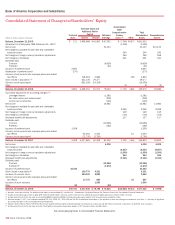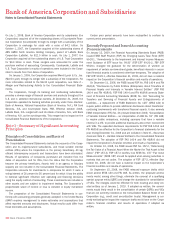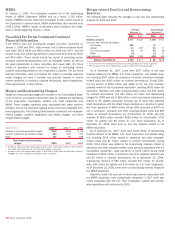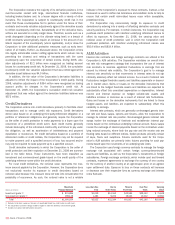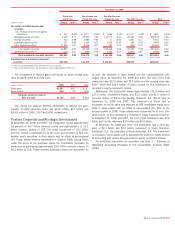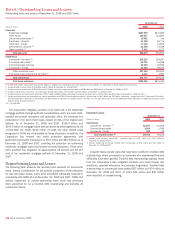Bank of America 2008 Annual Report Download - page 130
Download and view the complete annual report
Please find page 130 of the 2008 Bank of America annual report below. You can navigate through the pages in the report by either clicking on the pages listed below, or by using the keyword search tool below to find specific information within the annual report.Income Taxes
The Corporation accounts for income taxes in accordance with SFAS
No. 109, “Accounting for Income Taxes” (SFAS 109) as interpreted by
FASB Interpretation No. 48, “Accounting for Uncertainty in Income Taxes,
an interpretation of FASB Statement No. 109” (FIN 48), resulting in two
components of income tax expense: current and deferred. Current income
tax expense approximates taxes to be paid or refunded for the current
period. Deferred income tax expense results from changes in deferred tax
assets and liabilities between periods. These gross deferred tax assets
and liabilities represent decreases or increases in taxes expected to be
paid in the future because of future reversals of temporary differences in
the bases of assets and liabilities as measured by tax laws and their
bases as reported in the financial statements. Deferred tax assets are
also recognized for tax attributes such as net operating loss carryforwards
and tax credit carryforwards. Valuation allowances are then recorded to
reduce deferred tax assets to the amounts management concludes are
more-likely-than-not to be realized.
Under FIN 48, income tax benefits are recognized and measured
based upon a two-step model: 1) a tax position must be more-likely-
than-not to be sustained based solely on its technical merits in order to
be recognized, and 2) the benefit is measured as the largest dollar
amount of that position that is more-likely-than-not to be sustained upon
settlement. The difference between the benefit recognized for a position
in accordance with this FIN 48 model and the tax benefit claimed on a tax
return is referred to as an unrecognized tax benefit (UTB). The Corporation
accrues income-tax-related interest and penalties, if applicable, within
income tax expense.
For additional information on income taxes, see Note 18 – Income
Taxes to the Consolidated Financial Statements.
Retirement Benefits
The Corporation has established qualified retirement plans covering sub-
stantially all full-time and certain part-time employees. Pension expense
under these plans is charged to current operations and consists of sev-
eral components of net pension cost based on various actuarial assump-
tions regarding future experience under the plans.
In addition, the Corporation has established unfunded supplemental
benefit plans and supplemental executive retirement plans (SERPS) for
selected officers of the Corporation and its subsidiaries that provide
benefits that cannot be paid from a qualified retirement plan due to
Internal Revenue Code restrictions. The SERPS were frozen and the
executive officers do not accrue any additional benefits. These plans are
nonqualified under the Internal Revenue Code and assets used to fund
benefit payments are not segregated from other assets of the Corpo-
ration; therefore, in general, a participant’s or beneficiary’s claim to bene-
fits under these plans is as a general creditor. In addition, the
Corporation has established several postretirement healthcare and life
insurance benefit plans.
The Corporation accounts for its retirement benefit plans in accord-
ance with SFAS No. 87, “Employers’ Accounting for Pensions” (SFAS 87),
SFAS No. 88, “Employers’ Accounting for Settlements and Curtailment of
Defined Benefit Pension Plans and for Termination Benefits,” SFAS
No. 106, “Employers’ Accounting for Postretirement Benefits Other Than
Pensions,” and SFAS No. 158, “Employers’ Accounting for Defined Bene-
fit Pension and Other Postretirement Plans, an amendment of FASB
Statements No. 87, 88, 106, and 132(R)” (SFAS 158), as applicable.
Accumulated Other Comprehensive Income
The Corporation records gains and losses on cash flow hedges, unreal-
ized gains and losses on AFS debt and marketable equity securities,
unrecognized actuarial gains and losses, transition obligation and prior
service costs on pension and postretirement plans, foreign currency
translation adjustments, and related hedges of net investments in foreign
operations in accumulated OCI, net-of-tax. Accumulated OCI also includes
fair value adjustments on certain retained interests in the Corporation’s
securitization transactions. Gains or losses on derivatives accounted for
as cash flow hedges are reclassified to net income when the hedged
transaction affects earnings. Gains and losses on AFS debt and market-
able equity securities are reclassified to earnings as the gains or losses
are realized upon sale of the securities. Other-than-temporary impairment
charges are reclassified to earnings at the time of the charge. Translation
gains or losses on foreign currency translation adjustments are
reclassified to earnings upon the substantial sale or liquidation of
investments in foreign operations.
Earnings Per Common Share
Earnings per common share is computed by dividing net income available
to common shareholders by the weighted average common shares issued
and outstanding. Net income available to common shareholders repre-
sents net income adjusted for preferred stock dividends including divi-
dends declared, accretions of discounts on preferred stock issuances and
cumulative dividends related to the current dividend period that have not
been declared as of year end. In addition, for diluted earnings per common
share, net income available to common shareholders can be affected by
the conversion of the registrant’s convertible preferred stock. Where the
effect of this conversion would have been dilutive, net income available to
common shareholders is adjusted by the associated preferred dividends.
This adjusted net income is divided by the weighted average number of
common shares issued and outstanding for each period plus amounts
representing the dilutive effect of stock options outstanding, restricted
stock, restricted stock units, outstanding warrants, and the dilution result-
ing from the conversion of the registrant’s convertible preferred stock, if
applicable. The effects of convertible preferred stock, restricted stock,
restricted stock units, outstanding warrants and stock options are
excluded from the computation of diluted earnings per common share in
periods in which the effect would be antidilutive. Dilutive potential common
shares are calculated using the treasury stock method.
Foreign Currency Translation
Assets, liabilities and operations of foreign branches and subsidiaries are
recorded based on the functional currency of each entity. For certain of
the foreign operations, the functional currency is the local currency, in
which case the assets, liabilities and operations are translated, for con-
solidation purposes, at period-end rates from the local currency to the
reporting currency, the U.S. dollar. The resulting unrealized gains or
losses are reported as a component of accumulated OCI on an after-tax
basis. When the foreign entity’s functional currency is determined to be
the U.S. dollar, the resulting remeasurement currency gains or losses on
foreign denominated assets or liabilities are included in earnings.
Credit Card and Deposit Arrangements
Endorsing Organization Agreements
The Corporation contracts with other organizations to obtain their
endorsement of the Corporation’s loan and deposit products. This
endorsement may provide the Corporation exclusive rights to market to
the organization’s members or to customers on behalf of the Corporation.
These organizations endorse the Corporation’s loan and deposit products
and provide the Corporation with their mailing lists and marketing activ-
ities. These agreements generally have terms that range from two to five
128
Bank of America 2008


